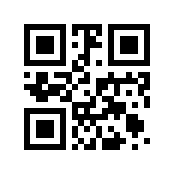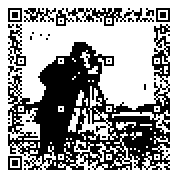Create QR Codes as data within Julia, or export as PNG.
Creating a QR Code couldn't be simpler.
julia> using QRCoders
julia> qrcode("Hello world!")
21×21 BitMatrix:
1 1 1 1 1 1 1 0 1 1 1 1 1 0 1 1 1 1 1 1 1
1 0 0 0 0 0 1 0 1 0 1 0 1 0 1 0 0 0 0 0 1
1 0 1 1 1 0 1 0 0 0 1 1 0 0 1 0 1 1 1 0 1
⋮ ⋮ ⋮ ⋮ ⋮
1 0 1 1 1 0 1 0 1 0 0 0 1 0 0 1 0 0 1 0 0
1 0 0 0 0 0 1 0 0 1 0 1 0 1 1 1 1 0 0 0 1
1 1 1 1 1 1 1 0 1 0 1 1 0 1 1 1 0 0 1 0 0The value 1(true) represents a dark space and 0(false) a white space.
Exporting files is also easy.
julia> exportqrcode("Hello world!")A file will be saved at ./qrcode.png.
QRCode is a structure type that contains the data of a QR Code. One can use
it as an input to call functions.
julia> code = QRCode("Hello world!")
█████████████████████████
██ ▄▄▄▄▄ █▀ █ ▄█ ▄▄▄▄▄ ██
██ █ █ █▄ █▀▄█ █ █ ██
██ █▄▄▄█ █ ██▀ █ █▄▄▄█ ██
██▄▄▄▄▄▄▄█ ▀ ▀ █▄▄▄▄▄▄▄██
██▄ ▀ ▀▀▄ ▀ ▄███ ▄▄█▄ ▀██
████▄ █ ▄▄ █▄▀▄▄███ ▄▀ ██
██████▄█▄▄▀ ▀▄█▄▀ █▀█▀██
██ ▄▄▄▄▄ █▄ ▀▀ █ ▀▄▄▄███
██ █ █ █▀▄▀ ██▄ ▄▀▀▀ ██
██ █▄▄▄█ █▀ █▄▀▀█▄█▄█▄██
██▄▄▄▄▄▄▄█▄█▄▄▄██▄█▄█▄███
▀▀▀▀▀▀▀▀▀▀▀▀▀▀▀▀▀▀▀▀▀▀▀▀▀
julia> qrcode(code) # get the data of the QR Code
julia> exportqrcode(code, "qrcode.png") # export to a file
julia> qrwidth(code) # get the width of the QR CodeThe show method of QRCode is a visual representation of the QR Code using
unicode characters ['█', '▀', '▄', ' '].
Besides, animated QR code is supported in version 1.3+.
julia> exportqrcode(["Hello world!", "Hello Julia!"], fps=2)The keyword fps controls the frame rate of the animation.
This part is still under development, see issue#33 for more information. Feel free to contribute or propose more ideas!
Plot an image inside a QRCode.
using TestImages, ColorTypes, ImageTransformations
using QRCoders
oriimg = testimage("cameraman")
code = QRCode("Hello world!", version=16, width=4)
img = imresize(oriimg, 66, 66) .|> Gray .|> round .|> Bool .|> !
imageinqrcode(code, img; rate=0.9) |> exportbitmat("qrcode-camera.png")Here rate is the damage rate of error correction codewords, it should be no greater than 1.
There are some optional arguments.
Keyword width with default value 0.
julia> qrcode("Hello world!", width=1)
23×23 BitMatrix:
0 0 0 0 0 0 0 0 0 0 0 0 0 0 0 0 0 0 0 0 0 0 0
0 1 1 1 1 1 1 1 0 1 1 1 1 1 0 1 1 1 1 1 1 1 0
0 1 0 0 0 0 0 1 0 1 0 1 0 1 0 1 0 0 0 0 0 1 0
⋮ ⋮ ⋮ ⋮ ⋮
0 1 0 0 0 0 0 1 0 0 1 0 1 0 1 1 1 1 0 0 0 1 0
0 1 1 1 1 1 1 1 0 1 0 1 1 0 1 1 1 0 0 1 0 0 0
0 0 0 0 0 0 0 0 0 0 0 0 0 0 0 0 0 0 0 0 0 0 0The QR Code will be surrounded by a white border of width width.
Keywords eclevel, version, mode and mask in qrcode:
-
Error correction level
eclevelcan be picked from four valuesLow(),Medium(),Quartile()orHigh(). Higher levels make denser QR codes. -
Version of the QR code
versioncan be picked from 1 to 40. If the assigned version is too small to contain the message, the first available version is used. -
Encoding mode
modecan be picked from five values:Numeric(),Alphanumeric(),Byte(),Kanji()orUTF8(). If the assignedmodeis failed to contain the message, it will be picked automatically. -
Mask pattern
maskcan be picked from 0 to 7. If the assignedmaskis not valid, it will be picked automatically.
Keywords in qrcode are also available in exportqrcode. Moreover, a new keyword pixels is used to control the size of the exported image.
julia> exportqrcode("Hello world!", "img/hello.png", pixels = 160, width = 0)This file will be saved as ./img/hello.png (if the img directory already exists), have a size of (approximately) 160 centimeters and be compact.
QR Codes can be encoded with four error correction levels Low, Medium, Quartile and High. Error correction can restore missing data from the QR code.
Lowcan restore up to 7% of missing codewords.Mediumcan restore up to 15% of missing codewords.Quartilecan restore up to 25% of missing codewords.Highcan restore up to 30% of missing codewords.
The four levels are encoded as types in QRCoders.jl, grouped under the abstract type ErrCorrLevel. Don't forget to use parentheses when you call the values: qrcode("Hello", eclevel = High()).
QR Codes can encode data using several encoding schemes. QRCoders.jl supports five of them: Numeric, Alphanumeric, Kanji, Byte and UTF8.
Numeric is used for messages composed of digits only, Alphanumeric for messages composed of digits, characters A-Z (capital only) space and % * + - . / : \$, Kanji for kanji for Shift JIS(Shift Japanese Industrial Standards) characters, Bytes for messages composed of one-byte characters(including undefined characters), and UTF8 for messages composed of Unicode characters.
Please note that QR Code reader don't always support arbitrary UTF-8 characters.
Another thing to point out is that, for Byte mode, we allow the use of undefined characters(Unicode range from 0x7f to 0x9f), following the original setting in QRCode.jl. For example:
julia> exportqrcode(join(Char.(0x80:0x9f)))QRCoders.jl was built following this excellent tutorial.
The original repository QRCode.jl was created during the Efficient Scientific Computing with Julia workshop, taught by Valentin Churavy at the Okinawa Institute of Science and Technology in July 2019. Slides available here.
The current version QRCoders.jl(≥v1.0.0) is proposed as part of the OSPP'2022 project.






